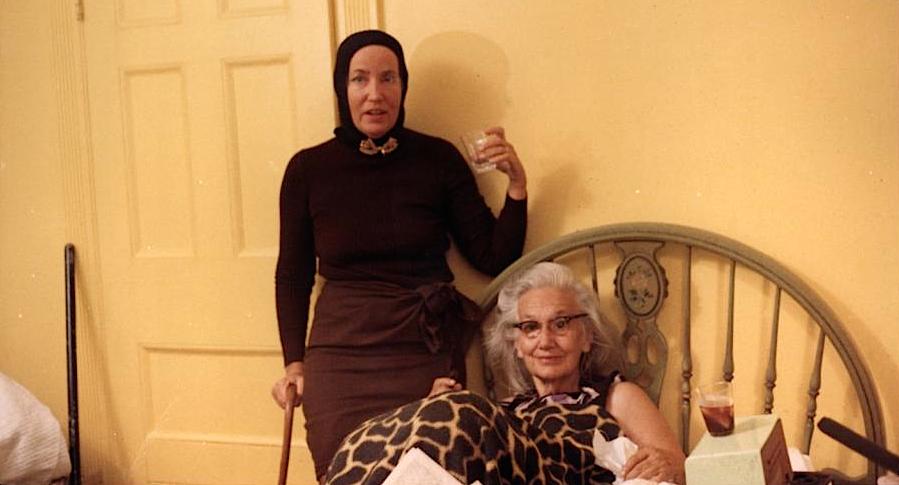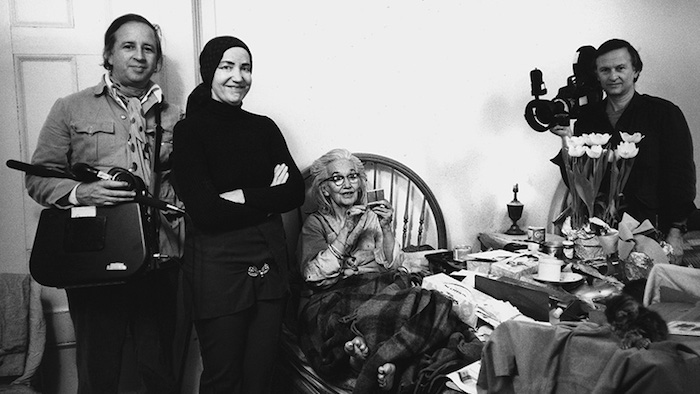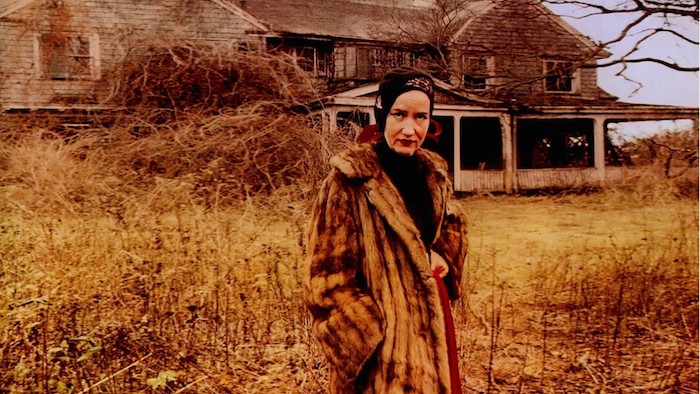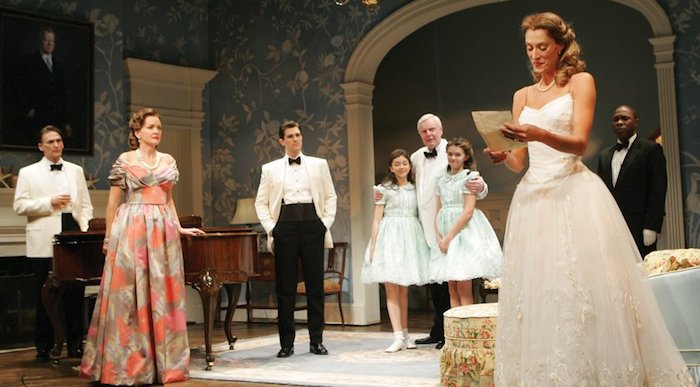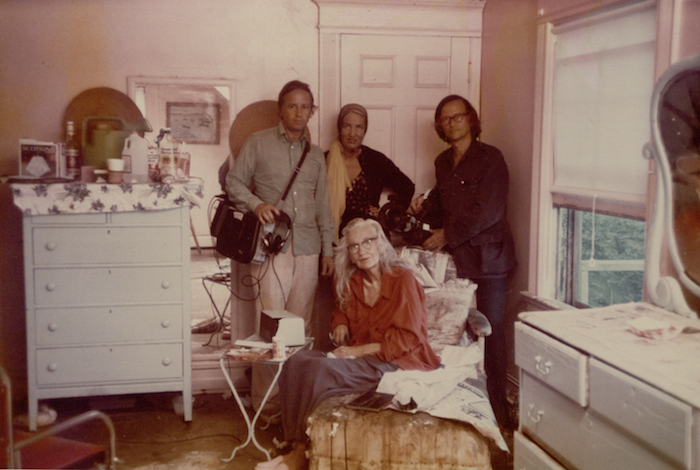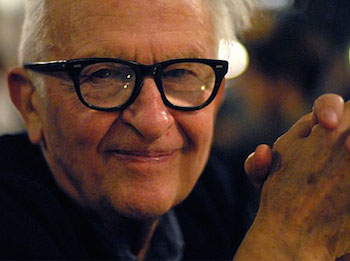 I feel so lucky that I was able to see the great documentary filmmaker Albert Maysles, who died yesterday at the age of 88, at last year’s TCM Classic Film Festival in Hollywood introducing a restored version of Grey Gardens, the 1975 classic he made with his late brother, David. Even though Albert was not in the best of health last year and had a little difficulty getting to the stage, his fondness for his subjects came through loud and clear. Is such an affinity always the best quality for a documentarian? I’m not sure, but it’s certainly a great quality for a human being.
I feel so lucky that I was able to see the great documentary filmmaker Albert Maysles, who died yesterday at the age of 88, at last year’s TCM Classic Film Festival in Hollywood introducing a restored version of Grey Gardens, the 1975 classic he made with his late brother, David. Even though Albert was not in the best of health last year and had a little difficulty getting to the stage, his fondness for his subjects came through loud and clear. Is such an affinity always the best quality for a documentarian? I’m not sure, but it’s certainly a great quality for a human being.
Tonight, Albert Maysles daughter, Sara, posted the following message on Facebook:
As many already know, my father passed away last night. His generosity of spirit, love, and kindness was felt by many. In his last minutes, he opened up his eyes wide and stared in the eyes of my brother, sister, mother, and me, one by one, as we cried and told him how much we loved him. It was beautiful to see that powerful gaze once more before he left us. Thank you everyone for your words of kindness. I’m a bit wiped so I’m going to head off of the digital world for the night, but know my family and I really appreciate your outpouring of support. And a reminder for us all: “Love your subject!” “Get close!”
I love that advice from Maysles: Love your subject! Get close! It’s something he clearly lived in his work. Albert and David obviously loved Big Edie and Little Edie, the eccentric women profiled in Grey Gardens, even though it would have been so easy and tempting to feel pity, disdain, or even contempt for some of their quirks.
I’ve always been intensely interested in the lives of people who are viewed by society as “crazy.” What were these people like earlier in their lives? Were there obvious signs of mental illness that were somehow masked by youth, beauty, or wealth? What ultimately led to these people’s losing their grip on reality? A long-standing chemical imbalance? A traumatic life event? Perhaps a descent into poverty coupled with a basic inability to cope? Maybe for some a dependency on alcohol or drugs? There is obviously not one answer.
Every time I see one of those “crazy” people on the street, there is a moment when I think to myself, “There but for the grace of God…” Let’s just say that there is a fairly generous dollop of mental illness in my gene pool. My father’s mother was institutionalized from the time he was a little boy. Some of my favorite relatives growing up were the people who my more “normal” family members would say were a few cards short of a full deck. Let’s face it, crazy Auntie Mame-types are always more fun, especially for an uptight kid who had already learned to suppress most of his feelings. I would dutifully play my part of the “good little boy” at all family events while secretly envying my family members who were volatile enough to break from the rules and cause a “scene.” I saw being crazy as a kind of freedom, a liberation from stifling norms, even though I simultaneously feared the loss of control it seemed to bring and I certainly didn’t envy the ramifications of such behavior, including, in some cases, being forcibly committed.
In the Maysles brothers’ Grey Gardens, we meet Edith “Big Edie” Beale, sister of Jacqueline Kennedy Onassis’s father, “Black Jack” Bouvier, and her daughter “Little Edie” who was once one of the most sought after young socialites in New York. By 1975, elderly Edie and her middle-aged daughter were recluses living in a decaying 28-room mansion called Grey Gardens in East Hampton, New York along with 52 cats, several rabid raccoons, and an occasional rat. The Suffolk County Health Department had declared the home “unfit for human habitation” in the early 1970s which caused Jackie O. to step in and pay for a cleaning and partial renovation. By the time the Maysles brothers arrived a few years later, the mansion was once again in an appalling state.
Throughout the film, the love/hate relationship between Big Edie and Little Edie is apparent. While the filmmakers were later dogged by accusations that they were exploiting the Beales, it’s clear that they had a great affection for their subjects and that the women loved being in the spotlight. Seeing them living in such squalor after having once been the toasts of New York society, I couldn’t help but think of the social, physical, and mental freefalls experienced by other well-to-do American families, including, to some extent, my own. Is that why Grey Gardens has become such a cult classic? Do we all relate on some level to the stubborn but fragile and vulnerable Beales?
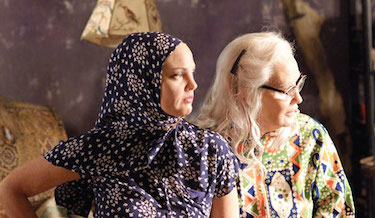 The film Grey Gardens practically spawned its own cottage industry. There were books about the Beales, an award-winning HBO film starring Jessica Lange and Drew Barrymore, and a Tony Award-winning musical that I became obsessed with long before I had the chance to see it on Broadway. When I first heard that someone was writing a musical based on the documentary, I thought it was insane. How could that possibly work? What was the point? But I was completely transfixed with the score from the first moment I played the CD. I was amazed at the way the emotions of these complex characters were so perfectly conveyed through the songs (written by Scott Frankel and Michael Korie). The fact that both Edies were frustrated singers in their own right lent itself to the production. Big Edie died in 1977 but before her death in 2002, Little Edie gave her blessing to the planned musical of the film — she loved the idea.
The film Grey Gardens practically spawned its own cottage industry. There were books about the Beales, an award-winning HBO film starring Jessica Lange and Drew Barrymore, and a Tony Award-winning musical that I became obsessed with long before I had the chance to see it on Broadway. When I first heard that someone was writing a musical based on the documentary, I thought it was insane. How could that possibly work? What was the point? But I was completely transfixed with the score from the first moment I played the CD. I was amazed at the way the emotions of these complex characters were so perfectly conveyed through the songs (written by Scott Frankel and Michael Korie). The fact that both Edies were frustrated singers in their own right lent itself to the production. Big Edie died in 1977 but before her death in 2002, Little Edie gave her blessing to the planned musical of the film — she loved the idea.
The musical version of Grey Gardens is two plays in one. The first act takes place in 1941, during the heyday of the Beale family when their mansion was well staffed and boasted the finest gardens in the Hamptons. What a brilliant move to take the older Beales, as documented by the Maysles in the 1975 film and work backwards 30 years to a time when they were young, attractive, and accepted by society. While the first act plays like a high-spirited Cole Porter musical, it’s impossible to miss the heavy strands of dysfunction that crisscross the seemingly carefree lives of mother and daughter. Every hopeful moment in the first act is made all the more poignant because of our knowledge of how these dynamic characters will end up.
Jackie Kennedy and her sister Lee Radziwill are characters in the play, little girls, aged 12 and 8, who are in awe of their kooky, talented aunt and beautiful cousin. As the musical opens, the older Edie is busy preparing Grey Gardens for a glittering party honoring her daughter’s engagement to Joseph Kennedy, Jr., bright star of the Kennedy family and older brother to Jack and Bobby. Although the two may have dated back in the day, Little Edie’s engagement to the oldest Kennedy son is a fictional element but a poignant one since we know that Joe Kennedy, too, will be cut down in his prime when his plane goes down towards the end of World War II. Little Edie was a debutante and model in her youth, known by the nickname “Body Beautiful Beale,” and besides Kennedy, was supposedly courted by J. Paul Getty, Howard Hughes, and two of the Rockefellers.
In the end, however, their eccentricities and the hands they were dealt led both Edies into seclusion, dumped by the society families that once clamored for their attention. Big Edie was abandoned by her husband and disowned by her own family, the Bouviers. She received no alimony from Mr. Beale but was allowed to keep Grey Gardens, the palatial home that slowly withered around her since she could not afford to keep it up. In the early 1950s, Big Edie summoned her daughter to the mansion to take care of her, thus beginning the co-dependent relationship that would comfort and torture both for the next two decades.
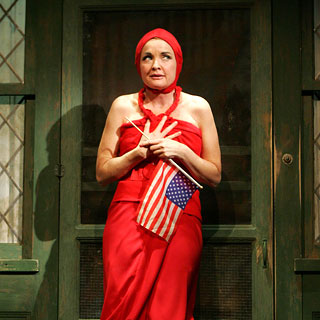 Christine Ebersole won a much-deserved Tony for her portrayal of Big Edie in Act 1 of the musical and an older Little Edie in Act 2. A lot of the dialogue from the film was incorporated into the play and the words seemed to take on a special poignancy when we heard them coming out of the younger versions of the characters. In some cases, whole songs were created from the dialogue such as Little Edie’s explanation of her bizarre ensembles that included sweaters wrapped around her head and held in place with an ornate brooch.
Christine Ebersole won a much-deserved Tony for her portrayal of Big Edie in Act 1 of the musical and an older Little Edie in Act 2. A lot of the dialogue from the film was incorporated into the play and the words seemed to take on a special poignancy when we heard them coming out of the younger versions of the characters. In some cases, whole songs were created from the dialogue such as Little Edie’s explanation of her bizarre ensembles that included sweaters wrapped around her head and held in place with an ornate brooch.
“This is the best thing to wear for today, you understand. Because I don’t like women in skirts and the best thing is to wear pantyhose or some pants under a short skirt, I think. Then you have the pants under the skirt and then you can pull the stockings up over the pants underneath the skirt. And you can always take off the skirt and use it as a cape. So I think this is the best costume for today.”
The Beales of East Hampton were like two modern-day Miss Havishams, sitting in their faded, dusty finery and waiting for the crowds of admirers who would never come. Except now they have.
I loved seeing Albert Maysles talk about the Beales last year when he presented his film. Albert’s brother, David Maysles, died at the age of 55 in 1987. Albert stayed in touch with Little Edie until her death in 2002 at the age of 84. I’d like to think that somewhere tonight, Albert, David, Little Edie, and Big Edie are reunited around a table, eating corn, listening to records, and talking about how, despite their various frailties, they all loved their subjects…and got close.

